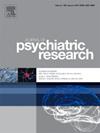Alexithymia and psychopathological dimensions in First-Episode Psychosis: Comparative patterns in natural cannabis versus synthetic cannabinoid users
IF 3.7
2区 医学
Q1 PSYCHIATRY
引用次数: 0
Abstract
Aims
This study aimed to investigate the differences in psychotic symptomatology, dissociative symptoms, alexithymia, and aberrant salience among three groups: non-cannabis users (NU), natural cannabis users (NC), and synthetic cannabinoid users (SCs). The study also explored the patterns of alexithymia and its associations with other psychopathological dimensions in these populations.
Methods
A total of 108 participants experiencing First Episode Psychosis (FEP) were recruited during psychiatric crisis presentations to emergency rooms in Italy and categorized into three groups (NU, NC, SCs; n = 36 each). Participants were initially assessed 48–72 h after inpatient admission following clinical stabilization. Psychopathological assessments were conducted using the Positive and Negative Syndrome Scale (PANSS), Dissociative Experiences Scale (DES-II), Aberrant Salience Inventory (ASI), and Toronto Alexithymia Scale (TAS-20). Evaluations occurred at baseline (T0), three months (T1), and six months (T2) post-admission. Statistical analyses included ANOVA and repeated-measures ANOVA comparisons across time points.
Results
SC users exhibited significantly higher positive psychotic symptoms, persistent aberrant salience, and limited recovery of alexithymia compared to NC users and non-users. Dissociative symptoms were more prominent in both NC and SCs users, with SCs users showing minimal improvement over time. Negative symptoms were higher in non-users but showed progressive reduction across all groups. Significant correlations were observed between alexithymia and specific aberrant salience subscales, particularly Feelings of Increased Significance and Sense Sharpening.
Conclusions
Synthetic cannabinoids are associated with more severe and persistent psychotic symptoms and emotional dysregulation compared to natural cannabis. Alexithymia and dissociation showed distinct patterns across user groups, with different trajectories of change over the six-month observation period. These findings underscore the need for targeted interventions addressing emotional regulation and salience processing in cannabis-related psychosis.
首发精神病的述情障碍和精神病理维度:天然大麻与合成大麻素使用者的比较模式
目的本研究旨在探讨非大麻使用者(NU)、天然大麻使用者(NC)和合成大麻素使用者(SCs)在精神病症状、解离症状、述情障碍和异常显著性方面的差异。该研究还探讨了这些人群述情障碍的模式及其与其他精神病理方面的联系。方法共招募了108名在意大利急诊室进行精神危机报告时出现首发精神病(FEP)的参与者,并将其分为三组(NU、NC、SCs;N = 36)。在临床稳定后入院48-72小时对参与者进行初步评估。采用阳性和阴性综合征量表(PANSS)、分离体验量表(DES-II)、异常显著性量表(ASI)和多伦多述情障碍量表(TAS-20)进行精神病理评估。在入院后基线(T0)、3个月(T1)和6个月(T2)进行评估。统计分析包括跨时间点的方差分析和重复测量方差分析比较。结果与NC使用者和非使用者相比,ssc使用者表现出更高的阳性精神病症状、持续的异常突出和有限的述情障碍恢复。解离症状在NC和SCs使用者中更为突出,随着时间的推移,SCs使用者表现出最小的改善。阴性症状在非吸毒者中较高,但在所有组中均逐渐减少。在述情障碍和特定异常显著性亚量表之间观察到显著的相关性,特别是重要性增加的感觉和感觉锐化。结论与天然大麻相比,合成大麻素与更严重和持续的精神病症状和情绪失调有关。述情障碍和解离在不同的用户组中表现出不同的模式,在六个月的观察期间有不同的变化轨迹。这些发现强调了在大麻相关精神病中进行有针对性的情绪调节和显著性处理干预的必要性。
本文章由计算机程序翻译,如有差异,请以英文原文为准。
求助全文
约1分钟内获得全文
求助全文
来源期刊

Journal of psychiatric research
医学-精神病学
CiteScore
7.30
自引率
2.10%
发文量
622
审稿时长
130 days
期刊介绍:
Founded in 1961 to report on the latest work in psychiatry and cognate disciplines, the Journal of Psychiatric Research is dedicated to innovative and timely studies of four important areas of research:
(1) clinical studies of all disciplines relating to psychiatric illness, as well as normal human behaviour, including biochemical, physiological, genetic, environmental, social, psychological and epidemiological factors;
(2) basic studies pertaining to psychiatry in such fields as neuropsychopharmacology, neuroendocrinology, electrophysiology, genetics, experimental psychology and epidemiology;
(3) the growing application of clinical laboratory techniques in psychiatry, including imagery and spectroscopy of the brain, molecular biology and computer sciences;
 求助内容:
求助内容: 应助结果提醒方式:
应助结果提醒方式:


